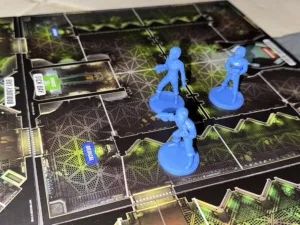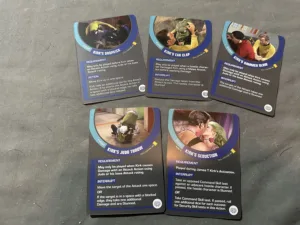 Here we are, back again with more Star Trek: Away Missions expansions. This time, what is old is new. The Original Series (TOS) gets its first representation in this game in the form of two expansions covering the entire TOS cast: Captain Kirk and Commander Scotty expansions. Naturally, they included Picard in the game first, but they couldn’t go long without addressing the elephant in the room that is the original captain. Like the shows is Picard still better than Kirk? Or does the Shat come out ahead for the first time?
Here we are, back again with more Star Trek: Away Missions expansions. This time, what is old is new. The Original Series (TOS) gets its first representation in this game in the form of two expansions covering the entire TOS cast: Captain Kirk and Commander Scotty expansions. Naturally, they included Picard in the game first, but they couldn’t go long without addressing the elephant in the room that is the original captain. Like the shows is Picard still better than Kirk? Or does the Shat come out ahead for the first time?
Expansions Overview:
Like the previous sets of expansions, there are two away teams, complete with minis, character boards, core missions, support and mission cards, and any necessary tokens. This time, however, both sets are Federation and are focused entirely on the Original Series cast. The Captain Kirk expansion has the classic trio of Kirk, Spock, and McCoy (with Chekov as the Specialist), while the Commander Scotty expansion rounds out the cast with Scotty, Sulu, and Uhura (plus Red Shirt Mr. Leslie… R.I.P.).

Similarly to the four preceding expansions, there are new core missions and supporting cards to push you toward new strategies. Both sets have a double-sided core mission, as well as 70 cards that help you with the strategies of the new core missions. Following the trend of the second wave of expansions, these two do also have a prebuilt pair of decks, which are great for getting you into the action without a lot of setup time. Good to see that they realized this was important after the first expansions lacked it.
As usual, the integration of these with your existing content isn’t too hard. You can either use the team and their cards right out of the box in place of one of your previous teams, or you can build your own decks from the larger card pool, based on whatever core mission you select (of which the Federation now has 8 options available due to the 4 double-sided cards). You can also substitute in a Specialist (like Geordi or Shelby) from a previous set into these teams in place of Chekov or Mr. Leslie, or vice versa.

Game Experience with the Expansions:
Like the Picard and House of Duras expansions before them, these need to differentiate themselves from the other teams in their faction, in this case, the Federation teams that are commanded by Riker and Picard. In doing so, they follow a similar formula to the wave 2 expansions. The core missions ask for different types of missions, and the characters support those more than others. For example, the Kirk expansion is the most combat-friendly of the Federation teams to date with the core mission Shoot to Kill, scoring you points based on the number of Conflict-tagged missions that you complete.
Many of the Support cards take you in that direction as well, with an entire suite of Kirk combat moves: Kirk’s Judo Throw, Kirk’s Ear Clap, Kirk’s Hammer Blow, and of course, the iconic Kirk’s Dropkick. It makes for a very different approach than when playing with Picard who is focused on winning through negotiations and avoiding combat. There is a bit of a dichotomy with the Kirk expansion, however, as the flip side of the core mission wants you to complete Contact missions, which are more peaceful and combat averse (this is why Spock is around!). The two sides of the Original Series are represented well in that way.

The Scotty expansion seems like it might have a harder time finding its niche, since the Riker team’s focus was a lot on repairing the ship, which you’d think the original Miracle Worker would be doing as well. It does have some of that to a degree, but it also has a very surprising mechanic which I was not entirely expecting: Tribbles. Cards let you place Tribble tokens onto the board, and they slowly (or perhaps too quickly?) reproduce, spread throughout the board, and interfere with everyone’s rolls, with an especially adverse effect on Klingons. If I had a Bingo card for what I expected to be in these expansions, this was not it, but it is an interesting addition and does give the expansion something unique.
The biggest new thing is across both sets. It is a mechanic called “Beam Away.” When a card tells you to Beam Away, you replace one of your characters with a Beam Away token, and then the card will indicate some form of attack or skill test (either opposed or unopposed) that the character needs to complete. If they succeed, you get to score the card and score the card, possibly also getting a bonus. However, there is risk involved. If the character fails, they are neutralized. This is used in various ways, and is often thematic. For example, the iconic episode “Arena” in which Kirk fights the Gorn captain with a rudimentary lathe… er, cannon, is represented by a Beam Away card which Beams Away both commanders and makes them attack one another till one is neutralized.

This is still a fairly early stage for the game, but I do have a few concerns. One being, they indicate that the only characters that should be swapped between teams are the Specialists, so if you are using Kirk, you always use Spock and McCoy, with the final slot being up for grabs (currently, the Federation Specialists are Shelby, Chekov, Geordi, and Mr. Leslie). The issue here is, there isn’t really indication of which non-commanders go with which commander. With an iconic trio like Kirk, Spock, and McCoy, this is easy to remember, but as there get to be more teams with lesser known characters (such as, so far, all the non-Federation expansions), keeping in mind who goes with who might be more difficult. The character tiles and the decks do have a yellow delta instead of a red delta like on the previous sets, but this only seems to indicate era (it was the same on the Picard expansion and the core set). It mostly gives me another reason to question the need for team-building rules to be restricted to only swapping Specialists.
My other concern is a fairly small one, and it is of all things, about the Tribbles. From a thematic standpoint, having the Tribbles mess more with Klingons than others is funny and fully on flavor. From a mechanical, gameplay perspective it feels like disproportionately effecting one faction over all of the others could be a bad thing. Maybe it doesn’t matter too much, since the effect here is rather small, and maybe it doesn’t come up later, but it was a concern that I noticed.
Final Thoughts:
These sets do provide something different from the previous expansions, while at the same time, they aren’t so complicated that you couldn’t just pick them up as your first expansions. The Tribbles, greater focus on combat, and Beam Away mechanic are something unique and different, but are not overly complex. If a person is a fan of the Original Series over The Next Generation (though someone would be crazy for thinking such a thing!), and have been waiting for it to be represented in the game, this is a good jumping in point. It also works for someone who has been fully invested in the game so far, as it isn’t just more of the same. While the actions at a base level are similar, the strategies are different, and it does feel like you’re going in a different direction. Kirk punching the bad guys in the face, instead of Picard sweet-talking them into agreeing with him. It keeps the game fresh.
Bottom line on these is they’re a good pickup if you enjoy the game so far. If you have been waiting on the Original Series, and are a big fan, now is a good time to get in as you will like these. There are a lack of Original Series adversaries, but I imagine they would be something that would be coming in the future. An Away team of Kor, Kang, and Koloth against Captain Kirk would be a thing of beauty.
 Hits:
Hits:
• Introduces new mechanics to switch things up, but don’t overly complicate the game.|
• Brings the Original Series cast into the game with appropriate flavor wins across the board.
• Comes with a rules card for Tribbles and Beam Away.
Misses:
• The lack of team-building is just going to become more of a glaring issue as more teams are added to each faction.
• To date, while the possibilities for expansion are wide open, they’ve only added teams. Would like to see other types of expansions.





















